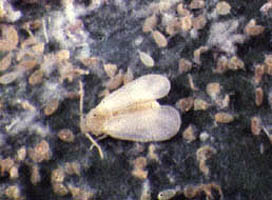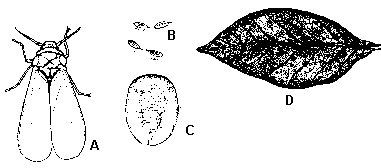|
|
Back to Pest Identification and Diagnosis
| Introduction to Whiteflies | Key to Whiteflies | Silverleaf Whitefly | Sweetpotato Whitefly | |||
| Greenhouse Whitefly | Citrus Whitefly |
CITRUS WHITEFLY
SCIENTIFIC NAME:
Dialeurodes citri (Ashmead)
CLASS: Insecta
ORDER: Hemiptera
FAMILY: Aleyrodidae
 |
 A. Adult B. Eggs C. Pupa D. Infested gardenia leaf |
|
|
Citrus Whitefly From: Aggie Horticulture |
Life Cycle From: NC Extension |
| DESCRIPTION | |
|
Adults: The adult is a tiny, moth-like, four-winged, mealy-white insect with a wing span of less than 4.3 mm. Most often they rest on the undersides of leaves and fly about when plants are disturbed. Eggs: The citrus whitefly lays yellow eggs with a nearly smooth surface. The eggs are about 0.25 mm long, elliptical, and most frequently laid on young tender leaves. Nymphs: The first instar is the only mobile nymphal stage. After the first instar the nymphs are flattened, oval, and similar in appearance to soft scale insects. Nymphs are translucent, oval in outline, and very thin. The leaf color will show through the thin nymphal body, therefore nymphs are difficult to see. Pupae: The pupal case is very similar to nymphs, but is slightly thickened and more opaque. The red eye spots of the adult are very prominent in developing pupal cases. |
|
| BIOLOGY | |
|
Distribution: Reported from Virginia southward and around to Texas, then westward to California. Host Plants: The primary host plant is citrus of all types, but many ornamentals are also hosts. The most common are Allamanda, banana shrub, Boston ivy, chinaberry, English ivy, gardenia, lilac, pear, osage orange, and privet. Damage: Direct damage is caused by the removal of sap. Indirect damage is caused by the excretion of copious amounts of honeydew where sooty molds grow. This black mold will contribute to poor aesthetics and perhaps interfere with photosynthesis. Life Cycle: Winter or colder periods are passed as late nymphal stages on the undersides of leaves. These may be on some remaining plants or weeds growing under benches. In the spring or when heat is applied adults will emerge and deposit eggs on the undersides of new plant growth. These eggs will hatch in 8 to 24 days, depending on the temperature. The nymphal stage will last from 23 to 30 days. Overall the life cycle from egg to adult will vary from 41 days to more than 300. The adult will live as long as 27 days. |
|
| CONTROL | |
|
Controls are difficult because the eggs and nymphs are located on the underside of leaves, and they may also be resistant to some aerosol chemicals. Adult control usually will involve multiple applications as the nymphs mature and all have emerged as adults. Some of the new synthetic pyrethroids make controls much more successful. However, chemicals must be alternated to lessen the chance of a chemical-tolerant or resistant population developing. In some states biological control using
Encarsia lahorensis has been very successful. This parasitoid should be functional in the Gulf Coast states and warmer areas of other states. |
| Introduction to Whiteflies | Key to Whiteflies | Silverleaf Whitefly | Sweetpotato Whitefly | |||
| Greenhouse Whitefly | Citrus Whitefly |
Back to Pest Identification and Diagnosis
 |
(C) Regents of the University of
Minnesota. All rights reserved. |
 |
 |